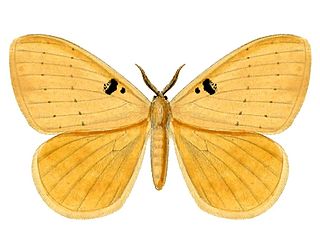
The flannel moths or crinkled flannel moths are a family of insects. They occur in North America and the New World tropics. The larvae are called puss caterpillars, and with their long hairs, resemble cotton balls. They have venomous spines that can cause a painful sting and inflammation lasting for several days. In some cases, the sting may cause headache, nausea, and shock-like symptoms. Perhaps the most notorious for stinging is the caterpillar of Megalopyge opercularis.

The Pretoria Forts consists of four forts built by the government of the South African Republic (ZAR) just before the outbreak of the Second Anglo-Boer War around their capital of Pretoria.

Bradina is a genus of moths of the family Crambidae.

Ganyra josephina, the giant white, is a butterfly in the family Pieridae. It is found from southern Texas through Mexico and Central America to northern South America. The habitat consists of open, dry, subtropical forests.

Megalopyge is a genus of moths in the family Megalopygidae.

Catajana is a monotypic moth genus in the family Eupterotidae described by Embrik Strand in 1910. Its only species, Catajana bimaculata, described by Hermann Dewitz in 1879, is found in Angola and the Democratic Republic of the Congo.
Megalopyge brunneipennis is a moth of the family Megalopygidae. It was described by Schaus in 1905. It is found in Brazil.
Megalopyge hina is a moth of the Megalopygidae family. It was described by Paul Dognin in 1911. It is found in Guyana.
Megalopyge albicollis is a moth of the family Megalopygidae. It was described by Francis Walker in 1855.
Megalopyge chrysocoma is a moth of the Megalopygidae family. It was described by Gottlieb August Wilhelm Herrich-Schäffer in 1856. It is found in Venezuela.
Megalopyge defoliata is a moth of the Megalopygidae family. It was described by Francis Walker in 1855. It is found in Mexico.
Megalopyge immaculata is a moth of the family Megalopygidae. It was described by Samuel E. Cassino in 1928.

Megalopyge lacyi is a moth of the family Megalopygidae. It was described by William Barnes and James Halliday McDunnough in 1910.

Megalopyge lanata is a moth of the family Megalopygidae. It was described by Caspar Stoll in 1780.
Megalopyge lecca is a moth of the family Megalopygidae. It was described by Herbert Druce in 1890.
Megalopyge nuda is a moth of the Megalopygidae family. It was described by Caspar Stoll in 1789. It is found in Guyana and Paraguay.

Megalopyge pixidifera is a moth of the Megalopygidae family. It was described by James Edward Smith and John Abbot in 1797. It was described from the southern United States.
Megalopyge salebrosa is a moth of the Megalopygidae family. It was described by James Brackenridge Clemens in 1860. It is found in Mexico and Guatemala.

Megalopyge xanthopasa is a moth of the family Megalopygidae. It was described by Sepp in 1828. It is found in Surinam and French Guiana.









